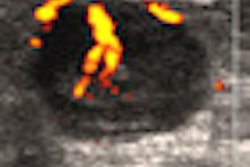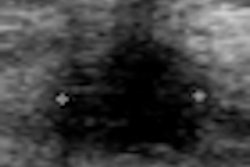CHICAGO - BI-RADS 3, or "probably benign," lesions are seen in a whopping 20% of patients after three rounds of screening ultrasound, but they are rarely malignant, according to researchers from Southwoods Imaging Center in Youngstown, OH.
However, because a BI-RADS 3 finding can worry patients, clinicians are seeking a way to better categorize these lesions.
In this Sunday morning RSNA 2011 session devoted to breast ultrasound, Dr. Richard Barr, PhD, presented results from a study he and colleagues conducted using data from the American College of Radiology Imaging Network (ACRIN) 6666 trial to ascertain the frequency and malignancy rate of BI-RADS 3 ultrasound lesions.
BI-RADS 3 lesions are very common in screening ultrasound and thus require additional follow-up or even biopsy, which can lead to significant patient anxiety, Barr told attendees.
"In fact, we found that BI-RADS 3 and BI-RADS 4 ultrasound lesions accounted for 71.6% of biopsies, but only 27.9% of detected cancers," he said.
Out of 2,662 trial participants, 519 (19.5%) had 745 BI-RADS 3 lesions on ultrasound, Barr's group found. Of these lesions, 124 (16.6%) were biopsied; six of these biopsied lesions were malignant (representing 4.8% of biopsies and 0.8% of BI-RADS 3 lesions). The six malignant lesions occurred in five (1%) of the 519 participants, and five of the six malignancies were invasive.
The study findings led Barr and his group to conclude that although BI-RADS 3 lesions are common on screening ultrasound -- in fact, making up approximately 25% of all lesions detected by the modality -- fewer than 2% are malignant upon biopsy.
How can the lesion categorization be improved? Elastography and tissue strain ultrasound show promise, Barr said. He cited two studies that are currently in press: Barr and his colleagues authored one of the studies, and the other is from Dr. Wendie Berg, PhD, from the University of Pittsburgh, and colleagues.
Berg's study showed that shear-wave elastography increased ultrasound's specificity from 61.1% to 78.5%, with no change in sensitivity. Meanwhile, Barr's study showed that tissue strain produced a cancer sensitivity of 98.5% and a specificity of 85%.
Evolving modality
The fact that the rate of BI-RADS 3 lesions in screening ultrasound is so much higher than mammography -- which hovers closer to 5% -- suggests that it's still developing, according to Dr. Jennifer Harvey of the University of Virginia. Harvey gave the keynote at the session.
"The goal is to try to better categorize ultrasound lesions, like we do with mammography," she told attendees. "For mammography, we have pretty defined criteria for putting a lesion the BI-RADS 3 category. Ultrasound, on the other hand, is still evolving, though there's an increasingly large body of literature now that we can draw on."
Harvey offered a framework for categorizing breast lesions found on screening ultrasound: BI-RADS 2 would include clustered microcysts, complicated cysts, and perhaps multiple solid masses (although she cautioned that there is not much literature support for the latter as of yet); BI-RADS 3 would include solid masses with benign features; and BI-RADS 4 would include any complex mass, new complicated cyst, or solid or enlarging mass.
Acting on ultrasound lesion characterization is far from standardized, Harvey noted. She tends to place solid masses with benign features that are palpable in a follow-up protocol, while others in her field might not.
"I do put [these masses] in follow-up, but many people choose to biopsy," she said.



















